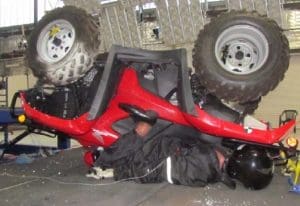
University of NSW tests with dummies show how quad bikes can crush a driver in a rollover. Photo – University of NSW.
A MANDATORY safety standard for quad bikes was the best option to save lives and make the vehicles safer for everyone, according to Australia’s consumer watchdog.
The Australian Competition and Consumer Commission has proposed major changes to improve the safety of quad bikes, including the introduction of a safety rating system, crush protection devices and mandatory minimum performance standards.
The ACCC is asking for submissions on safety options proposed in a consultation regulation impact statement by May 4 2018, before it makes a final recommendation to the government mid-year.
Quad bike accidents result in an average of 16 deaths in Australia each year. They also result in about six people per day attending a hospital emergency department and two of these requiring hospitalisation for serious injuries.
To help reduce the deaths and injuries associated with quad bikes, the ACCC is proposing a mandatory safety standard that:
adopts the US Standard and requires an additional rollover warning label
introduces a safety star rating system so safer vehicles get a higher rating
requires manufacturers to integrate an operator protection device, such as a crush protection device or roll over protection device in the design of new quad bikes
imposes minimum performance tests for dynamic handling, stability and mechanical suspension and requires that all wheels be able to rotate at different speeds.

ACCC commissioner Mick Keogh
ACCC commissioner Mick Keogh said the ACCC believed a mandatory safety standard incorporating all of those elements was the best option to save lives and make quad bikes safer for everyone.
“The ACCC has considered a range of evidence and views in making this draft recommendation.
We have consulted with industry representatives, quad bike manufacturers and retailers, farmers, consumers, academics, hospitals, health professionals, tourism operators, among many others,” he said.
More than 90pc of quad bikes meet US standard
Mr Keogh said the adoption of the current US standard was “not a big deal’ because more than 90 percent of the quad bikes that had come into Australia were already compliant with the US standard.
“There are a small number that come in that aren’t, so we saw that as an important first step,” he said.
Safety rating to help consumers
Mr Keogh said the proposal for a safety star rating system was to help consumers make an informed choice.
“The issue is that people needing to understand the nature of the risks associated with quad bikes can’t easily make that choice based on the information available at the moment.
“That is where the notion of a rating system came in to provide an opportunity to identify which bikes were safer and which ones weren’t,” he said.
Rollover protection needed
Perhaps the most contentious proposal was the requirement for manufacturers to integrate an operator protection device on new machines.
“We are aware of arguments for and against this, but the most compelling information to us was the fact that 50 percent of the fatalities from quad bikes involve rollovers where the victim is asphyxiated because the machine ends up on top of them and they can’t breathe,” Mr Keogh said.
“There is no escaping those statistics.
“There will be a substantial improvement in those statistics if quad bike roll-over protection in some form is available,” he said.
“For example, there was a Queensland quad bike tour operator who was having awful trouble with serious injuries, who implemented a mandatory rollover protection on all their quad bikes and had dramatically reduced the number of serious injuries from rollovers.”
Mr Keogh said the NSW and Victorian Governments had been providing incentives for people to put rollover protection on their bikes and the farming sector had given strong support for that.
However, he said there has been some criticism from some sectors, such as the horticulture industry where the rollover protection might be a problem where there was a need for riding under low trees.
“For that reason we haven’t been very specific about the design of the rollover protection, but have been specific about what it should achieve.
“To be approved it would have to be able to bear nearly two times the weight of the vehicle and also have enough space for the operator to crawl out,” he said.
“That allows, for example, in a horticulture situation maybe having a lower trajectory rollover protection than otherwise.”
Mr Keogh said manufacturers had opposed rollover protection and believed training was the way to go.
“We don’t doubt that training brings benefits.
“The difficulty we run into is that quite a significant number of the accidents involve a person who is not the trained person,” he said.
“In other words, 16 year old and under, or someone who visits the farm.
“We weren’t prepared to stop at training as a solution for solving the problem.”
Performance requirements improve safety
Mr Keogh said the final requirement for applying minimum handling and stability standards would also improve safety levels.
“There is clear evidence that having unlockable differentials and independent suspension on all four wheels reduces the propensity to rollover significantly, compared to a vehicle with fixed suspension or a fixed differential,” he said.
“Quad bikes that have those two characteristics are considerably safer, particularly on rollovers on turns, than ones that have rigid axles or rigid suspension system.
“We limited that to ‘utility’ quad bikes which are the bikes that would normally be used in a farming situation, so they are not used as sport bikes,” Mr Keogh said.
“We recognise that will impose slightly higher costs, although manufacturers make those options already in certain models.
“Overseas they have moved to a situation where those options are required.”
Consultation deadline May 4 2018
The ACCC has developed a Consultation Regulation Impact Statement, which details the proposed options to make quad bikes safer.
“I encourage stakeholders to consider the proposed options to improve the safety of quad bikes and make their submission by 4 May 2018, before we make a final recommendation to the Government mid-year” Mr Keogh said.
If you currently own or ride a quad bike, the ACCC strongly recommends that you follow safety advice on Product Safety Australia. Improving the safety of quad bikes is a product safety priority for the ACCC in 2018.
There are about 190,000 quad bikes in operation in Australia used for in workplaces, recreation, adventure tours and competitive racing.
Currently about 16,000 quad bikes are sold each year in Australia and they are one of the leading causes of death and injury on Australian farms. Since January 1 2011, 114 people have died in quad bike-related incidents.
Source: ACCC.



HAVE YOUR SAY